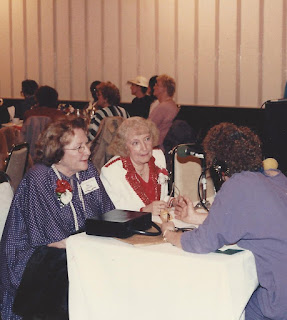This is the list of women musicians honored that day:
Jeanne E. Aiken, violinist, players’ representative of the Los
Angeles Philharmonic
Luruth Anderson, violin, assistant conductor, Los Angeles Women’s
SymphonyAnita Aros (Tuttle), violin, with The Spade Cooley Show
Micki “O” Bailey, played with Sweethearts of Rhythm and with Helen Gissin
Deedie (Glee) Ball, piano, played with Ina Ray Hutton’s band, toured with Hormel Show; also bandleader
Sally Banning (Porter), bandleader, organ, and saxophone
Audrey Barnett, guitar, producer, played with Ada Leonard, Peggy Gilbert, and George Liberace
Dixie Blackstone (
Margaret H. Brady, violin, Long Beach Women’s Symphony, conductor
Radie
Clora Bryant, jazz trumpet, with Prairie View’s All Girl Band, with the Sweethearts of Rhythm, among other bands
Evelyn “Evie”
Stella Castelucci, harp, symphonic and studio musician
Geneva Merle Chappele (Guerrero), drums
Mildred Portney Chase, pianist and writer, performed on the Evening on the Roof concerts
Maria Coker (Dickerson), bass, played USO tours
Lorenza Jordan Cole, pianist and educator
Joyce Collins, piano, bandleader; one of the first women to serve on the Board of Local 47, AF of M
Dorothy Compinsky, violin, Los Angeles Women’s Symphony, Brodetsky Ensemble, and The Compinsky Trio
Zackie Walters Cooper, saxophone
Katherine (Katy) Cruise, saxophone, clarinet, played with Boots and Her Buddies, Nellie Jay and Her Jay Birds, and Peggy Gilbert
Mary Demond, trumpet, played with Ada Leonard
Rose Diamond, piano, President of Women’s Club of Musicians Union
Karen Donley, bass, played with Peggy Gillbert’s band and the Dixie Belles, also Ina Ray Hutton
Marion Downs, singer of spirituals and promoter of Black American music
Eunice Johnson Duroe, trombone, played with Ada Leonard’s band
Marie Ford (O’Sullivan), violin, appeared in The Great Waltz, with Peggy Gilbert’s band
Peggy Gilbert, saxophone, bandleader, vocalist, arranger, clarinet, vibes, violin
Kellie Greene, piano, French horn, flute and arranger, and her own band
Virginia Gregg, bass, with the Singing Strings on radio, actress
Helen Gissin, drummer, vocalist, bandleader
Audrey Hall (Petroff), saxophone, clarinet and violin, with Peggy Gilbert’s band
June Robin Howard, violin
Davida Jackson, organ, studio work
Fern Spaulding Jaros, trombone and French horn, played with Babe Egan and the Hollywood Redheads and in symphonies
Dody Jeshke, drums
Feather Johnson, bass and reeds, played with Peggy Gilbert, Freddie Schaeffer and Joy Caylor
Alberta Jones, cello, played with Los Angeles Women’s Philharmonic
Francis Kass, trumpet, played with Ada Leonard
Sally Brown (
Ruth Kirkpatrick, violin,
Ann Leaf, theater organist and studio musician
Ada Leonard, bandleader and vocalist
Thelma L. Lewis, played with Sweethearts of Rhythm
Bernice Lobdell, trumpet, played with Ada Leonard, Ina Ray Hutton’s band, Count Bernivici and Rita Rio
Nellie Lutcher, piano, vocalist, songwriter, and bandleader
Barbara Neece MacNair, piano, with Ada Leonard
Elva Dilthey MacNair, saxophone and violin, played with Babe Eagan and the Hollywood Redheads
Lois Cronen Magee, trombone and vibraharp, played with Ina Ray Hutton and with Ada Leonard
Virginia Majewski, viola, played with the American Quartet
Marilyn Mayland, bass, with Los Angeles Women’s Philharmonic and her own group
Mildred Myers, played with Phil Spitalny’s All-Girls Orchestra
Bridget O’Flynn, drums
Alice Oakason (Dexter) drums, played with Fanchon and Marco and Peggy Gilbert’s band, studio musician
Rose Parenti, piano, played with Fanchon and Marco
June Smith Parra, cello, studio musician and teacher
Harriet Payne, viola, composer, conductor, played with Glendale Symphony, Long Beach Symphony, studio musician
Evelyn Pennak, saxophone, toured
Pearl Powers, bass, with Peggy Gilbert and the Dixie Belles, played with The Wild Ones and Four Guys and the Doll
Naomi “Pee Wee” Preble, trombone, with Peggy Gilbert’s band
Doris E. Pressler, trumpet with Bobby Grice and The Bricktops, Peggy Gilbert’s band
Eunice Wennermark Price, violin, studio musician
Bessie Van Wagner Quinzel, clarinet, Long Beach Women’s Symphony and band leader
Dorothy Ray, accordion, saxophone and producer
Charlotte (Robin) Reed, trumpet, with Count Bernivici’s band and Thelma White
Naomi Reynolds, piano, organ and radio broadcaster
Lois Robbins, trombone and bass, with Count Bernivici’s band
Natalie Robin, clarinet, oboe, and saxophone, with Peggy Gilbert and the Dixie Belles, played with Rita Rio and Ina Ray Hutton
Betty “Roz” Rosner, saxophone, clarinet, played with Sweethearts of Rhythm and Ada Leonard
Frances Rossiter, trumpet
Florence Russell, publisher of Pacific Coast Musician
Jane Sager, trumpet, played with Ona Munson, Peggy Gilbert, Ada Leonard, and Ina Ray Hutton
Eudice Shapiro, violin with the American Quartet, USC faculty and performed on the Evening on the Roof concerts
Mary Crawford Shattuck, violin, in Los Angeles Women’s Symphony concertmistress, played with International Strings
Georgia Cotner Shilling, piano, with Peggy Gilbert and the Dixie Belles
E. Ginger Smock Shipp, violin, with Spade Cooley television show and studio musician
Constance Shirley, composer
Ethel (Jenkins) Siegfried, bass, in Los Angeles Women’s Symphony
Lucille B. Silverstone, piano, played at the Brown Derby Restaurant
Barbara Simons, violin and viola, symphony player
Mildred Springer, bass, played with Ada Leonard
Geraldine Stanley
Verna Arvey Still, piano, lyricist and writer
Ann Mason Stockton, harp, studio musician
Florence L. Strnad, bassoon, Los Angeles Women’s Symphony
Pat Stullken, saxophone, played with Sweethearts of Rhythm
Norma Teagarden (Friedlander), piano
Jerrie Thill, drummer, vocalist, with Peggy Gilbert and the Dixie Belles and Ada Leonard.
Bee Turpin (
Elisabeth Waldo, violin and composer
Elinor Remick Warren, composer
Gayle Warren, piano
Marian “Marnie” Wells, trumpet, bass with Peggy Gilbert and the Dixie Belles, Ina Ray Hutton, Rita Rio and Count Bernivici
Wilma Wescott, tuba and entertainer
June (
Olive Williams, clarinet, with Los Angeles Women’s Symphony
Violet
Judy Winsor, piano, played at Brown Derby Restaurant
These women were in their 60s, 70s, 80s, and 90s when they were honored in 1986. How precious to have them together at the Ambassador Hotel that International Women's Day!







